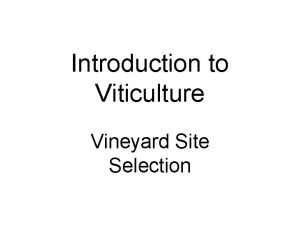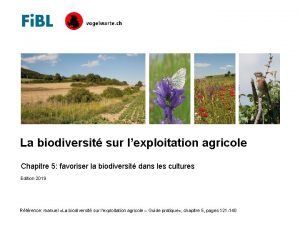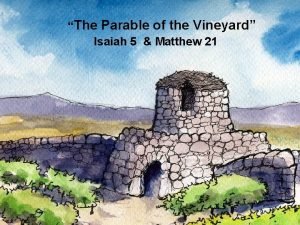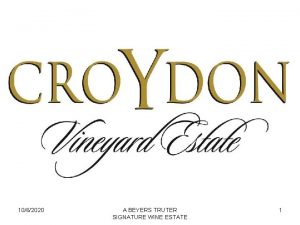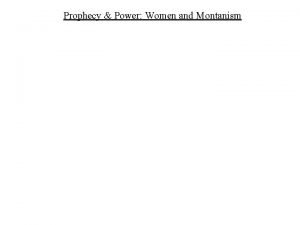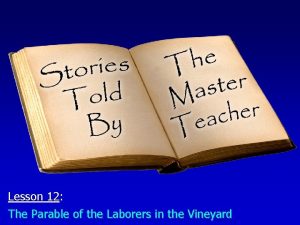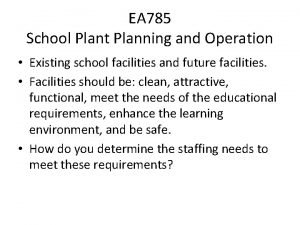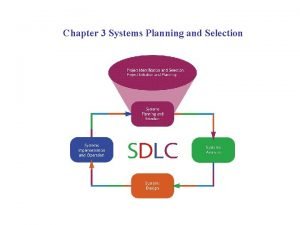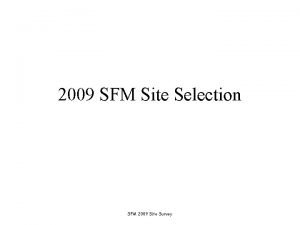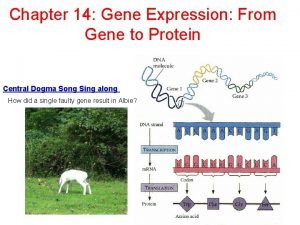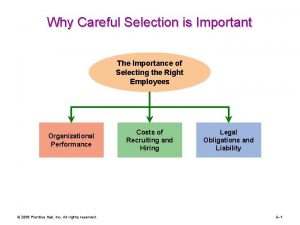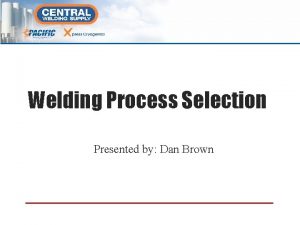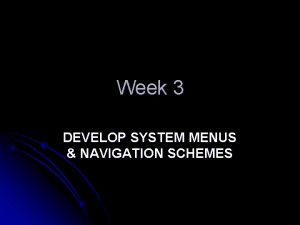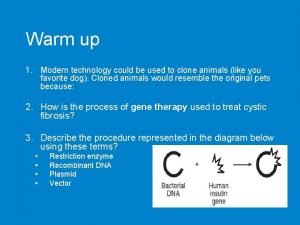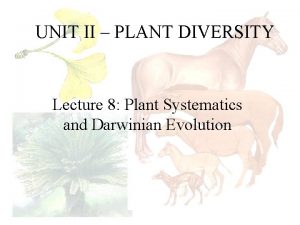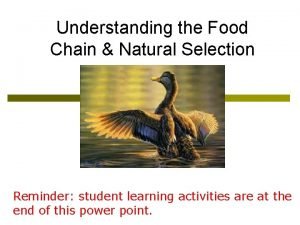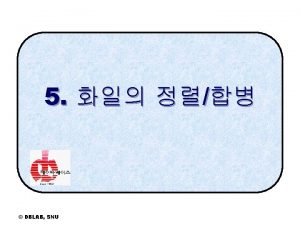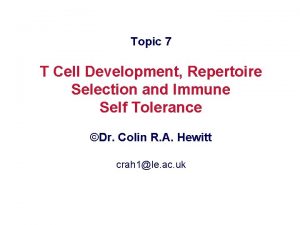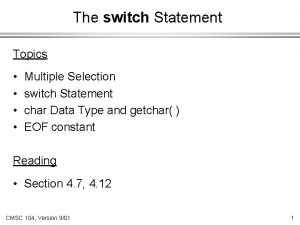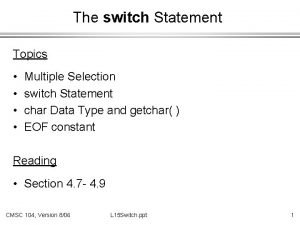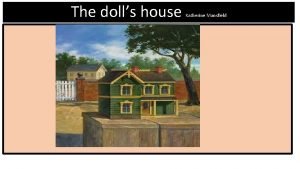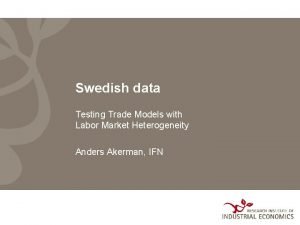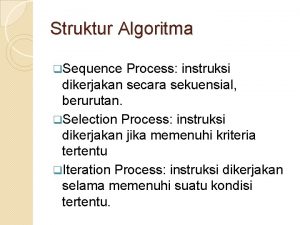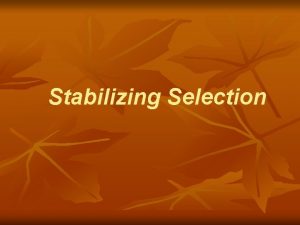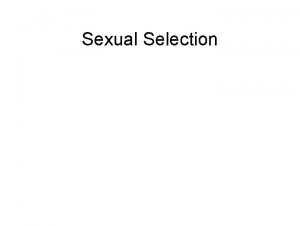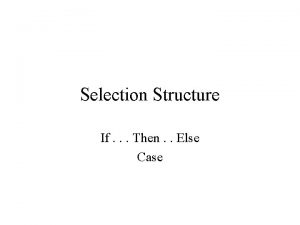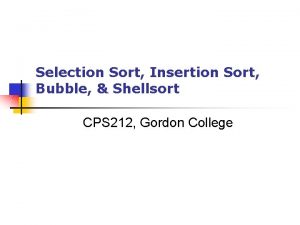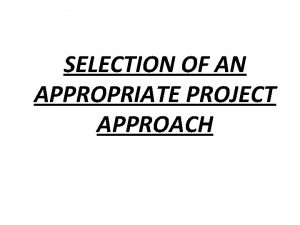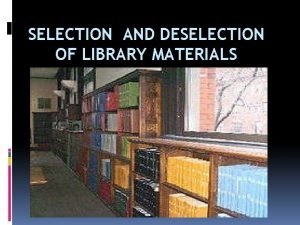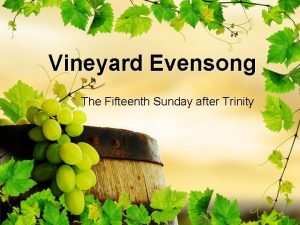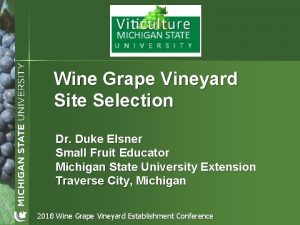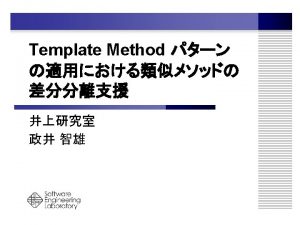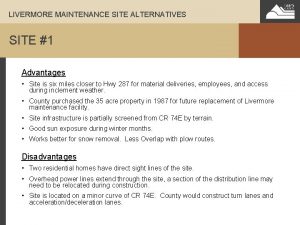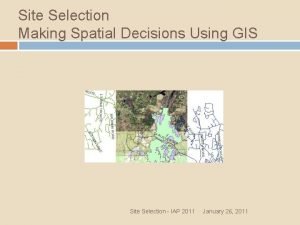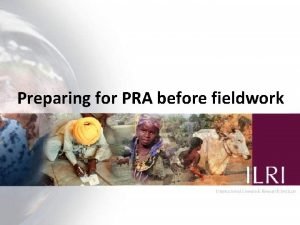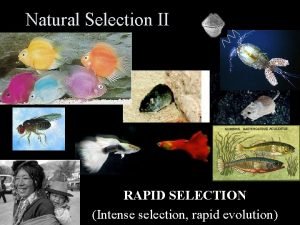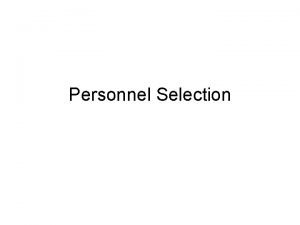Introduction to Viticulture Vineyard Site Selection I Introduction




































































- Slides: 68

Introduction to Viticulture Vineyard Site Selection

I. Introduction • A. The first consideration for successful investment in a new vineyard is the selection of an outstanding site. • B. This strategic and critical step will condition all the future performance of the vineyard not only in the years of establishment, but also for the rest of the more than 20 years of the expected vineyard life.

• C. Essential to success in any vineyard is a favorable combination of locality, variety of grapes, and proper utilization of the crop: – Riesling wines of Germany – Ohanez grapes of Spain – Thompson Seedless raisins of California • Cannot be easily duplicated in any other part of the world.

• D. It may be assumed that only a region meeting the general requirements would be under consideration. (Lecture # 4) • E. One must then make a study of the region in order to choose the district best suited to the class of grape to be grown. • F. If one already has a tract of land, study of conditions is required to determine the type of grape that can successfully be grown.

• G. If grapes are already being grown in the district, the necessary information can probably be gained by observing the success of the local industry and the difficulties encountered, and then comparing these with similar observations made in other districts.

II. Important Factors to Consider • • • A. Topography B. Climate C. Soil D. Neighboring Land E. Potential Pest and Threats F. Non-environmental Factors

III. Topography • A. Elevation – 1. Elevation is a factor known to dramatically influence the climate of a site. – 2. With every 150 feet gain in elevation the average temperature decreases 1 degree F. – 3. Viticulture areas in Missouri range from 300 to 1300 feet. – 4. Elevation has a profound influence on the minimum and maximum temperatures in a vineyard, particularly hilly terrain.

– 5. Because frosts and freezing temperatures can dramatically reduce vineyard profitability, elevation is one of the most important features of vineyard site suitability. – 6. The physics of topography effects on air temperature are well documented. • A. Under radiational cooling conditions, with calm winds and clear skies, the earth loses heat to space and cools the adjacent layer of air. • B. If the vineyard is on a slope, the cold, relatively dense air moved downhill.

• C. This movement can be pronounced in hilly areas. • D. The sinking, cold air displaces warmer air to higher elevations producing thermal inversions and thermal belts. • E. Above these relatively warm belts, air temperature again decreases at an average rate of 3. 6 degrees F/1000 feet of increase in elevation. • F. The sinking, cold air collects in low-lying areas and can create frost pockets.

• G. A very high percent of spring freezes are cause by radiational freeze situations. • H. Vineyards in low-lying frost pockets are much more prone to spring and fall frost damage and winter cold injury, than are vineyards that have been established at higher elevations. • I. A combination of local experience and research can be used to define the upper and lower limits of the desired thermal belt or zone for the hill/valley region.


• B. Slope – 1. Slope is the inclination or declination that a parcel of land varies from the horizontal, usually expresses as a percentage. • A. A five foot drop over a 100 feet horizontal distance would be a 5% slope. • B. Perfectly flat land would have a 0% slope. • C. A vertical cliff would have a 100% slope.

– 2. Slope can be accurately measured with an inexpensive, handheld inclinometer. – 3. A slight to moderate slope is desirable because it accelerates the drainage of cold air away from the vineyard. Cold air is denser than warm air and tends to flow downhill, much like a fluid. – 4. Generally, the steeper the slope, the more pronounced the temperature differential with changes in elevation.

– 5. Cold air also tends to moves downhill faster on steeper slopes. – 6. Water also drains more quickly down steep slopes. • A. Pro – Good Drainage; No Waterlogging. • B. Con – Erosion!! – 7. It is dangerous to operate equipment on slopes steeper than 15%. • Terracing of slopes is possible but will add significantly to the cost of vineyard establishment.

• C. Aspect – 1. Aspect of the slope refers to the prevailing compass direction which the slope faces (east, southeast, etc. ) – 2. Aspect will affect the angle that sunlight hits the vineyard and thus the total heat balance


IV. Climate • A. Temperature – Vines’ Genetic Limitations

Length of Growing Season in Missouri

Length of Growing Season in Eastern Missouri • • 175 180 185 190

Length of Growing Season • <150 • 150 -160 • 160 -170 • 170 -180 • > 200 American, Early Maturing French-hybrid American, Several Early Hybrids Early Maturing Viniferas, French hybrids Vinifera & Hybrids Most Viniferas Late maturing Viniferas

– Spring Frost Damage • Fluctuating temperatures are a big problem with fruit production in Missouri. • Fruit buds freeze at 28 degrees F. • Is influenced by growing season length • Is influenced by topography • Is influenced by adjacent vegetation • Windbreaks/air drainage • Stage of plant development

– Air Temperature Influences Rate of Photosynthesis/Rate of Respiration • • • Yield Growth Fruit Quality Flower Initiation Bloom Fruit Set/Growth/Development

Cold Winter Injury – 1. Assessing Cold Injury of Grape Buds • A. Choose buds similar to those you will save during pruning. This means the lower nodes of the canes of the better quality on the vines. • B. Sample based upon differences in you vineyard. This can be by variety, rootstock or based upon site and soil differences (lower vs upper sections, better or less well drained etc. ) • C. Collect at least 100 nodes from each section.

• D. If the freeze was recent and the buds may not have thawed since exposure to potentially harmful temperatures, then bring the warm canes into a warm room, keep the canes moist and wait for 2448 hours before examining the buds. This allows the damaged cells to thaw and the oxidative reactions which reveal damage to happen. • E. Cut the buds and record the number of live and dead primary buds. • F. You can also record the status of the secondary and tertiary buds. This is worthwhile information but not as important as primary bud survival.

Longitudinal Section of a Grape Bud (note three growing points or buds)

This is the region of the bud which should be examined to assess primary bud injury. The colored area is the compresses primary shoot for the next season.

This is the region of the bud which should be examined to assess secondary bud injury. It is adjacent to the leaf scar.

This is the region of the bud to examine to assess damage to the potential tertiary shoot.

The Examination • On the left is an intact grape bud. The leaf scar is to the left. The bulge on the left side of the bud is the secondary bud. The right picture shows a longitudinal view. In the series below the top view of a bud having successive horizontal slices removed is shown (click on the thumbnails to see the bigger picture). The line on the right shows the approximate level of the horizontal cut.

Intact bud

First cut. This is too shallow only the tips of the bud scales have been cut. The secondary bud is just beginning to be revealed at the lower left quadrant of the cut.

Second cut. This cut is still too shallow. The secondary bud is better defined, but only the tips of bud scales have been cut.

Third cut This cut shows a life primary bud. The cut has been through what will become a shoot internode. People often worry about whether the color is bright green, olive green or sort of gray. Just so long as the bud is not blackened, it is alive. • The tertiary bud can now be seen, but only bud scales of the secondary and tertiary buds have been cut.

Fourth cut • This is a good level to assess the health of the secondary and teritary buds, but it is too deep to assess primary bud health. Once the cut moves to the base of the shoot (the bud cushion), the status cannot be assessed. Dead buds will often be found on live bud cushions.

Fifth Cut • This cut is too deep. Only bud cushion is revealed. There may be dead primary, secondary and tertiary buds on top of a live bud cushion. Deep cuts may give a false sense of security.

The primary bud of this bud has died. The secondary bud is alive. The tertiary bud cannot be evaluated at this level of cut. • The above series shows why a single cut will not reveal the complete status of the buds nor even allow certainty as to the status of the primary bud. A series of shallow cuts is recommended.

• 2. Responding to Winter Cold Injury to Grapevine Buds – There are three ways to deal with cold: • A. Avoid the cold stress • 1. Find a warm place to grow grapes this is site selection • 2. Protect the buds or tissues from exposure to cold by burial or other means.

B. Tolerate the cold • 1. Grow a variety with sufficient cold hardiness to tolerate the expected temperatures. • 2. Maximize the maturity of the tissues you grow by applying excellent viticulture.

• 3. Tolerate the cold injury – A. If all the above ground vine tissues are killed, there is little you can do except replant or retrain from below the ground, but partial vine death is much more common.

– B. Delay pruning as long as feasible so that the danger of cold injury is reduced. (If December, January and February have passed without extreme cold, the danger is reduced. March may still produce damaging temperatures, but your odds of avoiding injury have increased. ) – C. If you suspect possible cold damage, examine the buds and proceed on the basis of actual injury.

• 3. Compensating for bud injury – A. If you know buds have been injured, you can retain more to compensate for the proportion of dead buds. Remember even when there is no cold damage, it is not uncommon for 10% or more of the buds not to develop.

– B. % dead primary buds – Compensation • 0 – 20 • Do not change normal pruning practice • 20 - 80% • Increase the number of buds retained in proportion to the injury • >80% • Prune away only those nodes which will intrude into the space of adjacent vines or which will produce fruit so low that it hangs to the ground

Cane Damage (right cane has suffered from cold damage)

• B. Spring Freeze Damage – 1. Is best controlled by site selection – 2. Can also be controlled (to some extent by) • • A. Heaters B. Overhead Sprinklers C. Evaporative Cooling D. Chemical Applications

• Heaters – High Fuel Cost – Operation logistics – Energy-efficiency – Air Pollution

• Overhead Sprinklers – Does not rely on inversion – Initial investment and operating cost per acre are cheater than heaters – No extensive labor to operate – Clean and Quiet – Fuel efficient – Waste Water – Water logging of soil possible – Nutrient leaching – Application rate is critical – Separate installation for irrigation and frost protection

• Evaporative Cooling – Preventative or passive protection method since the sprinkler system is turned on well before a spring frost event. – Although this method has been successful in delaying bud break of grapevines, evidence of protecting crop from frost injury is uncertain.

• Chemical Application – Claimed to provide freeze protection and prevent crop damage by unknown mode of action. – Inconsistent results over the last five decades have discourages widespread use – Growers should beware about believing the promotional claims of these materials.

• Grape Plant Chilling Requirements – Vinifera – Labrusca 100 -400 chilling hours 1200 -1500 chilling hours Temperatures most effective in meeting the chilling requirements of plants are between 37 -50, with most commonly accepted between 32 -45. Temperatures above 59 will reverse the chilling process.

• B. Rainfall – Rain provides needed water for grape growth. – On average, annual rainfall in the Southeastern part is Missouri averages 50 inches per year. – Mature grape vines can use 24 -30 inches of rainfall per year. – But Missouri summer precipitation occurs in thunderstorms quite often.

– Erratic rainfall distribution, often coupled with soil of low water infiltration rates and/or shallow soil with low water holding capacity, can lead to water stress for grapes. – Supplemental irrigation is a useful tool for optimizing yields and quality.


• Macro-, Meso-, and Micro-Climate – Macro-Climate – Missouri or even Mid-west averages. – Meso-Climate – A single field or hill side. Influenced by aspect, slope, elevation, barriers to air drainage. – Micro-Climate – The environment beneath the grape canopy. Influenced by humidity, shade and air movement.

V. Soil • • • Organic Matter Water Holding Capacity Depth Erosion p. H Micro-organisms

• Soil Organic Matter – Plant and animal residue in various stages of decay – Improve the physical and chemical condition of the soil – A source of nutrients for micro-organisms – A source of plant nutrients

• Micro-organisms – Improve soil structure – Improves root penetration – Facilitates water entrance and percolation – Increases water-holding capacity – Improves drainage

• Soil Compaction – Soil Texture


• Soil Drainage – Well drained soils have uniformly bright colors such as brown, yellow, red or combinations of these colors. The surface may be darkened by organic matter. – Uniform light gray colors in the profile indicate prolonged saturation with water. – Surface light gray soils, water stands on surface for prolonged periods in summer. – Mottled or bright brown, yellow intermixed with gray spots the soil is saturated.

• Internal Soil Drainage (If poor) – Reduced accessibility by equipment – Small vine size – Reduced productivity – Increased hazard of winter injury

• Root Depth – Capable of rooting to a depth of more than 20 feet. – Typically are concentrated in the upper 36” – Sometimes even in the upper 18”

• Soil Chemistry – Nutrients in the soil are most available for uptake when the soil is relatively neutral (ph=7. 0) – A comprehensive soil test including micronutrients should be evaluated.

VI. Neighboring Land • Wildlife – – Deer Birds (including wild turkey) Raccoons (especially in irrigated vineyards) Opossums • Phenoxy Herbicides – Broadleaf weed killers (2, 4 -D) used in corn field will cause dramatic injury to grapes. – 2, 4 -D can travel in humid, windy conditions for several miles.

VII. Potential Pest and Threats • Diseases – Pierce’s Disease

VII. Potential Pest and Threats North American Grapevine Yellows

Black Walnut Toxins

VIII. Non-environmental Factors • • • Proximity to Market Reputation of Region Availability of Labor Force Availability of Services (water/power) Accessibility by road (trucks/tourist)

IX. Viticulture Suitability Ranking • • Elevation Slope Land Use Aspect 35 points 20 points 10 points
 Vineyard site selection
Vineyard site selection Viticulture
Viticulture Vineyard kerk
Vineyard kerk Parable of the workers in the vineyard powerpoint
Parable of the workers in the vineyard powerpoint Parable of the vineyard isaiah 5
Parable of the vineyard isaiah 5 Croydon vineyard estate
Croydon vineyard estate Farnham vineyard
Farnham vineyard Parable of the lifesaving station
Parable of the lifesaving station Hot site cold site warm site disaster recovery
Hot site cold site warm site disaster recovery Balancing selection vs stabilizing selection
Balancing selection vs stabilizing selection Similarities
Similarities K selected
K selected Natural selection vs artificial selection
Natural selection vs artificial selection Artificial selection vs natural selection
Artificial selection vs natural selection Disruptivr selection
Disruptivr selection K selection r selection
K selection r selection Natural selection vs artificial selection
Natural selection vs artificial selection Two way selection and multiway selection
Two way selection and multiway selection Multiway selection in c
Multiway selection in c Mass selection and pure line selection
Mass selection and pure line selection School site selection process
School site selection process School plant
School plant What is system selection and planning
What is system selection and planning Factors affecting site selection of bridge
Factors affecting site selection of bridge Trading area analysis definition
Trading area analysis definition Data center site selection
Data center site selection Site selection savannah
Site selection savannah Introduction to recruitment and selection
Introduction to recruitment and selection Modular architecture
Modular architecture Site analysis conclusion
Site analysis conclusion Untangle vpn setup
Untangle vpn setup Introduction paragraph format
Introduction paragraph format Why careful selection is important
Why careful selection is important Selection of welding process
Selection of welding process New and navigation schemes selection of window
New and navigation schemes selection of window Example of physiological adaptation
Example of physiological adaptation Recruitment process meaning
Recruitment process meaning What is an example of artificial selection
What is an example of artificial selection Requirements for natural selection
Requirements for natural selection Replacement selection sort
Replacement selection sort Where does negative selection occur
Where does negative selection occur 4 principles of natural selection
4 principles of natural selection Multiple selection statement
Multiple selection statement Multiple selection statement
Multiple selection statement Story of an hour quiz
Story of an hour quiz Non probability sampling self selection
Non probability sampling self selection The origin of language curriculum development
The origin of language curriculum development Run away selection
Run away selection Plot structure of the doll's house by katherine mansfield
Plot structure of the doll's house by katherine mansfield Database selection criteria
Database selection criteria Control structure types
Control structure types Struktur algoritma sequence
Struktur algoritma sequence What is staffing process
What is staffing process Stabilizing natural selection definition
Stabilizing natural selection definition Bubble sort vs selection sort
Bubble sort vs selection sort Difference between insertion sort and bubble sort
Difference between insertion sort and bubble sort Sort popular
Sort popular Sorting pseudocode
Sorting pseudocode Selection vs bubble sort
Selection vs bubble sort Run away selection
Run away selection Winner tree
Winner tree Selection tools in management
Selection tools in management Case structure pseudocode
Case structure pseudocode Selection sort best case
Selection sort best case Difference between selection sort and bubble sort
Difference between selection sort and bubble sort Selection of objectives
Selection of objectives Selection of an appropriate project approach
Selection of an appropriate project approach Selection placement
Selection placement Sunlink weed of the month
Sunlink weed of the month
